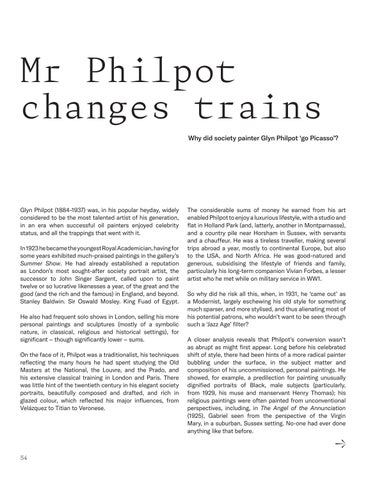Mr Philpot changes trains Why did society painter Glyn Philpot ‘go Picasso’?
Glyn Philpot (1884-1937) was, in his popular heyday, widely considered to be the most talented artist of his generation, in an era when successful oil painters enjoyed celebrity status, and all the trappings that went with it. In 1923 he became the youngest Royal Academician, having for some years exhibited much-praised paintings in the gallery’s Summer Show. He had already established a reputation as London’s most sought-after society portrait artist, the successor to John Singer Sargent, called upon to paint twelve or so lucrative likenesses a year, of the great and the good (and the rich and the famous) in England, and beyond. Stanley Baldwin. Sir Oswald Mosley. King Fuad of Egypt. He also had frequent solo shows in London, selling his more personal paintings and sculptures (mostly of a symbolic nature, in classical, religious and historical settings), for significant – though significantly lower – sums. On the face of it, Philpot was a traditionalist, his techniques reflecting the many hours he had spent studying the Old Masters at the National, the Louvre, and the Prado, and his extensive classical training in London and Paris. There was little hint of the twentieth century in his elegant society portraits, beautifully composed and drafted, and rich in glazed colour, which reflected his major influences, from Velázquez to Titian to Veronese.
54
The considerable sums of money he earned from his art enabled Philpot to enjoy a luxurious lifestyle, with a studio and flat in Holland Park (and, latterly, another in Montparnasse), and a country pile near Horsham in Sussex, with servants and a chauffeur. He was a tireless traveller, making several trips abroad a year, mostly to continental Europe, but also to the USA, and North Africa. He was good-natured and generous, subsidising the lifestyle of friends and family, particularly his long-term companion Vivian Forbes, a lesser artist who he met while on military service in WW1. So why did he risk all this, when, in 1931, he ‘came out’ as a Modernist, largely eschewing his old style for something much sparser, and more stylised, and thus alienating most of his potential patrons, who wouldn’t want to be seen through such a ‘Jazz Age’ filter? A closer analysis reveals that Philpot’s conversion wasn’t as abrupt as might first appear. Long before his celebrated shift of style, there had been hints of a more radical painter bubbling under the surface, in the subject matter and composition of his uncommissioned, personal paintings. He showed, for example, a predilection for painting unusually dignified portraits of Black, male subjects (particularly, from 1929, his muse and manservant Henry Thomas); his religious paintings were often painted from unconventional perspectives, including, in The Angel of the Annunciation (1925), Gabriel seen from the perspective of the Virgin Mary, in a suburban, Sussex setting. No-one had ever done anything like that before.













